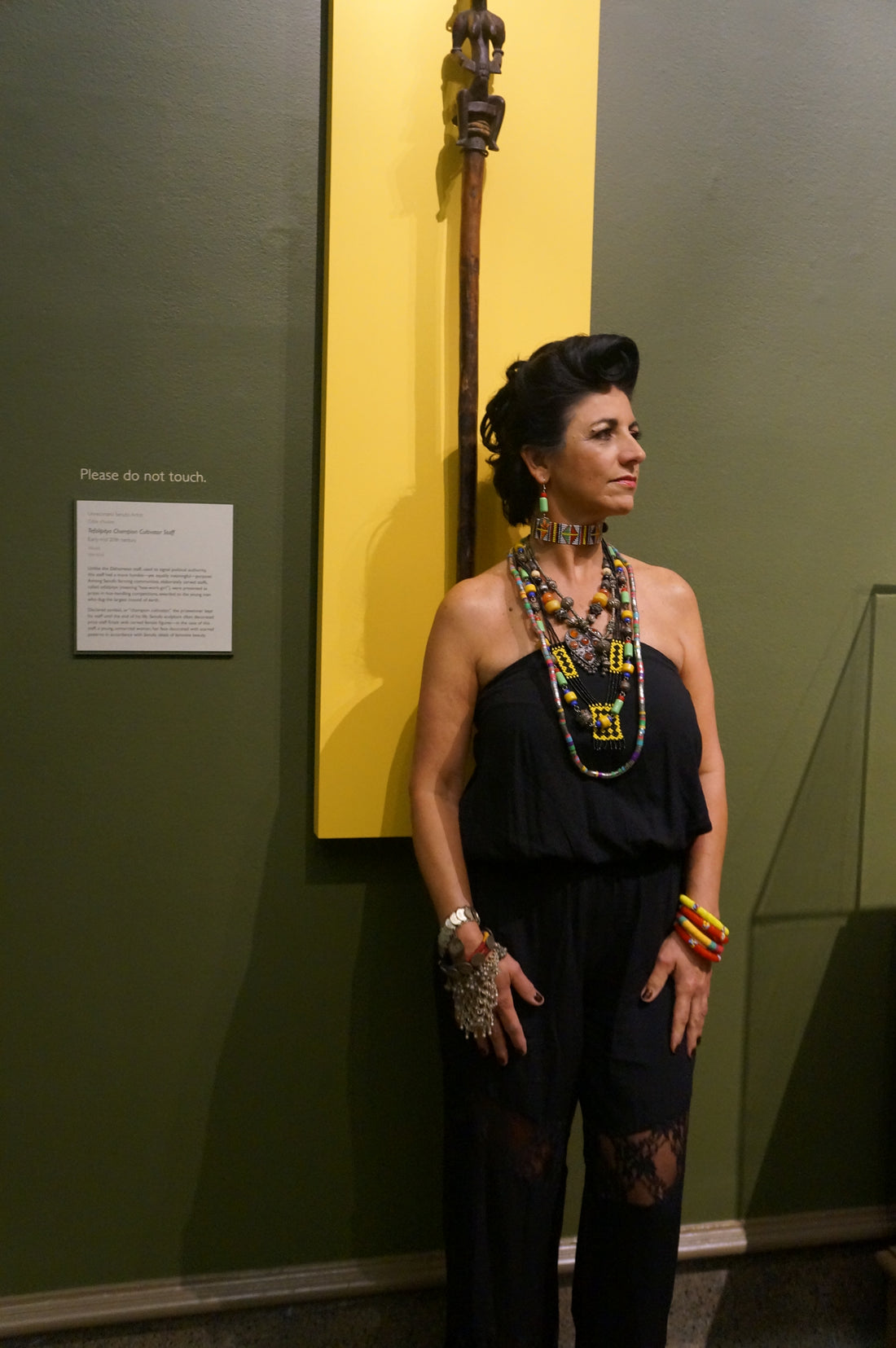
Symbolism & Style: The Diverse Jewelry of Africa
Symbolism & Style: The Diverse Jewelry of Africa by Morgan Watkins
Africa: a continent represented by diverse cultures, art and rich history. While it would be nearly impossible to put into words the beauty of this land, part of Africa’s charm can be appreciated through the jewelry created and worn by tribes and peoples across its regions. Saturated in vivid colors, constructed through various mediums and holding deep symbolism, African accessories are much more than strings of beads and copper wire. Keep on reading to learn more about Africa’s intricate and intriguing jewelry.

(Image from https://www.trekearth.com/gallery/Africa/Kenya/East/North_Eastern/Samburu_National_ Park/photo127575.htm)
It is said that jewelry in Africa dates back as far as 10,000 B.C., where jewelry was first constructed of simple natural resources. Animals were utilized not only to feed tribes, but also to create unique pieces made from bones, hides, and horns. Before trade was introduced to Africans, sticks, clay, seeds, shells, coral and stones could be foraged and utilized to fashion up jewelry. Beads became another valuable item for accessory making, as well as trade. Evolving from simple seeds to small glass ornaments, Africans were able to use aggri beads to barter with Europeans who entered the continent during the 15th and 16th centuries, when the African slave trade was beginning to rise. The more beads Africans had, the more valuable they were in the eyes of slave traders.

(Image from https://www.pinterest.com/pin/165648092516531850/?lp=true)
Speaking of beads, these tiny round items also serve a gaggle of other purposes. Dzi beads, echinacea beads and amber beads can either be consumed or worn by individuals, as they are utilized medically and as dietary supplements. Newborns commonly receive bracelets containing these beads as a way to physically and spiritually protect them from the outside world. Similarly, the dead also take these pieces to the grave. On a lighter note, waist beads, or strings of beads worn just above the hips, serve as a symbol of fertility, protection, seduction and healing. These accessories celebrate womanhood and femininity while ensuring prosperous reproductive health.

(Image from https://www.behance.net/gallery/5767485/Dipo-Ceremony-Krobo-Ghana)
For the Maasai people, beads are utilized to communicate various meanings via color codes. For example, red beads symbolize bravery and unity, white beads represent health and peace, and blue beads are used as a sign of energy. Not only that but the types of beaded necklaces worn by women communicate the marital status of the wearer. Unmarried women don flat beaded disc necklaces while soon to be married ladies sport elaborate, heavily beaded jewelry. Those who are married wear long strands of blue beads around their necks. Like the Maasai, Nigerian woman, too, wear accessory pieces to represent their courting status, which is presented in the form of woven bracelets.

(Image from http://www.freakingnews.com/Masai-Woman-in-Colorful-Clothes-Pictures-83725.asp)
Maasai women of high society are often styled in the most colorful beads around in order to show off their status. And like the Maasai, the Ashanti also use jewelry to represent social strata. Accessories in the Ghana region are usually limited to upper class individuals, who favor gold bracelets, armlets, anklets, rings, headdresses and more. Women of the Fulani, another tribe that loves gold jewelry, characteristically wear massive gold earrings as a symbol of wealth; the bigger the earrings, the richer the family.

(Image from https://interesting-africa-facts.com/African-Jewelry/Fulani-Earrings.shtml)
Egyptians, however, view their jewelry in a different light. Pieces created from gold and copper, often complimented with lapis lazuli, carnelian, and turquoise, hold spiritual significance and protect individuals from devilish spirits and bad energy. Egyptians wouldn’t even part with their beloved amulets and talismans when faced with death, as they believe their accessories could be carried with them into the afterlife.The Berber and Tuareg people also believe in jewelry’s spiritual powers, refusing to wear silver as it was deemed a metal of bad luck. Their jewelry is usually large in size, heavy in weight, and intricate in design. Geometric shapes are common templates for the Saharan region, and crosses are passed on from father to son in the Tuareg communities as a means to combat evil.

(Image from http://www.styleskier.com/five-interesting-facts-about-egyptian-jewelry/)
African men and women alike favor gold, but instead of wearing bracelets and necklaces like the ladies of Africa, men tend to prefer helmets and headdresses. Chieftains in Senegal model weighty gold head plaques, while Ashanti men at the Ivory Coast lean towards helmets constructed from stiffened animal hides that are embellished with gold leaves and wooden ornaments.

(Image from https://www.pinterest.com/pin/134474738844835952/?lp=true)
All in all, the intensely diverse and magnificent cultures of Africa all have one thing in common: their jewelry are works of art. Pieces like beaded necklaces and gold plated headdresses are a reflection of Africa’s people and their beauty, making this jewelry more than just jewelry. With a bounty of symbolism instilled in these pieces, African accessories perfectly embody how fashion can represent not only personal style and values, but also the world and the incredible cultures it encompasses. Looking for some stunning African inspired jewelry to add to your accessory arsenal? Be sure to check out our favorite styles on talkingfashion.net!
References:
Bello, Ebun. “Let’s Talk about African Gold Jewelry – History and Symbolism.” Zoede, 12 Nov. 2017,
https://zoede.com/lets-talk-african-gold-jewelry-history-symbolism/.
Fiandaca, Sean. “5 Things You Didn’t Know About Maasai Beadwork.” Thomson
Safaris,18 Oct. 2016, https://thomsonsafaris.com/blog/5-things-didnt-know-maasai-beadwork/. Katsande, Rukariro. “The Importance of Beads and Beadwork in African Culture.”
Wilderness Safaris, 11 Nov. 2014,https://wilderness-safaris.com/blog/posts/the-importance-of-beads-and-beadwork-in-african-culture.
Katsande, Rukariro. “The Importance of Beads and Beadwork in African Culture, Part II.” Wilderness Safaris,18 Nov. 2014,https://wilderness-safaris.com/blog/posts/the-importance-of-beads-and-beadwork-in-african-culture-part-ii.
Kimani, Natalie. “ANCIENT AFRICAN JEWELRY: Design History on the Continent.”The Designers Studio,22 Nov. 2017, http://tdsblog.com/ancient-african-jewellery/.
